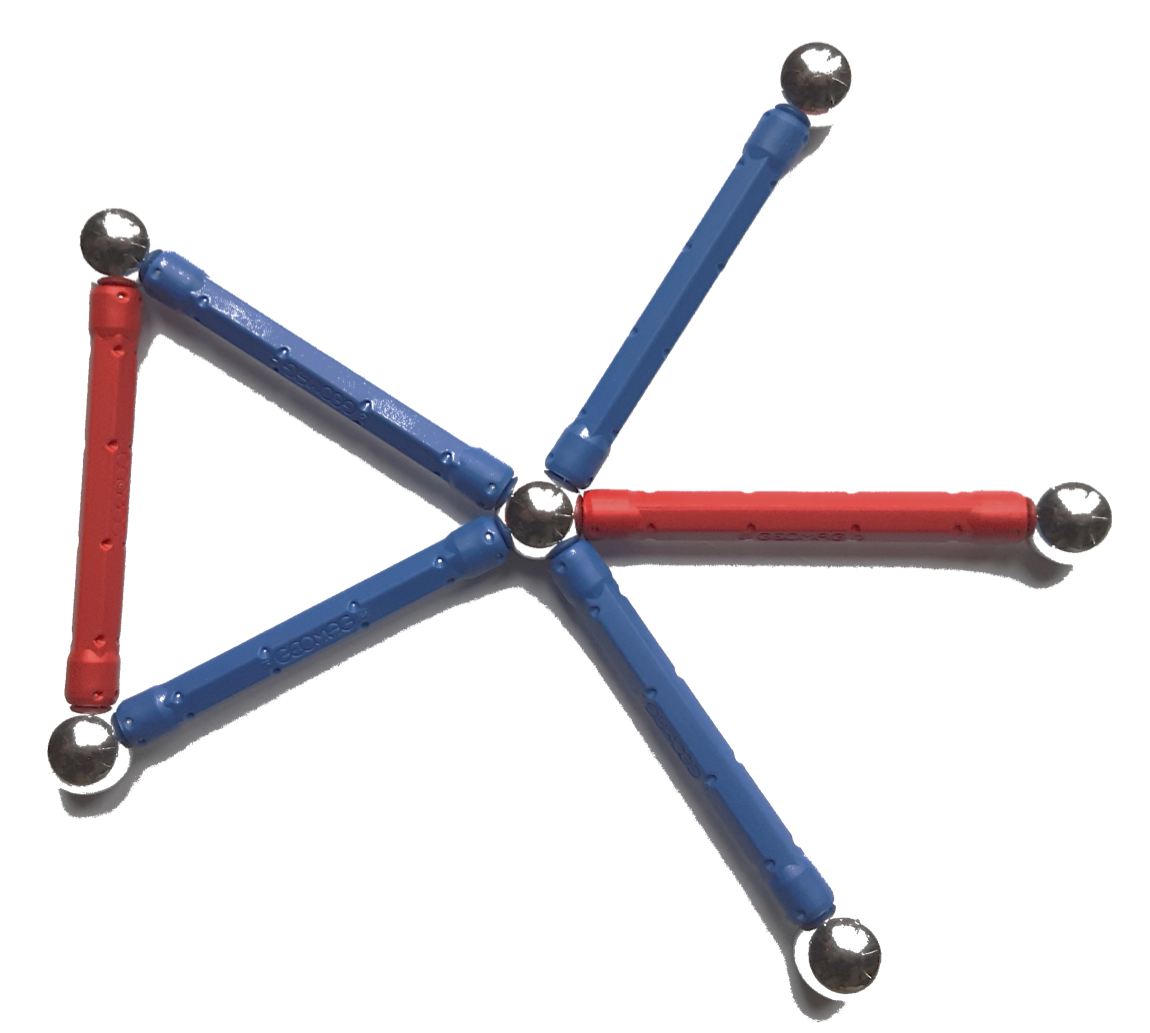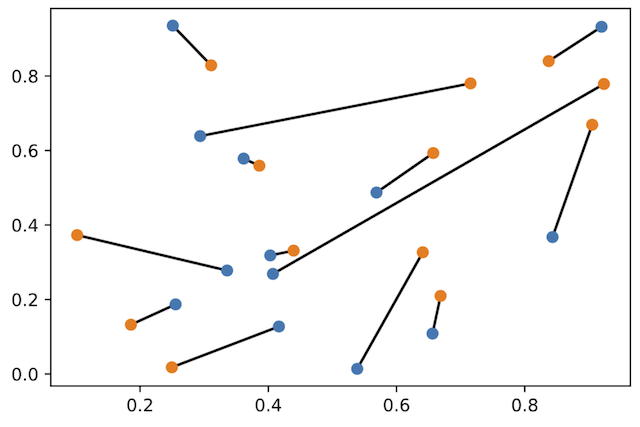Matching¶
A matching in a graph \(G = (V, E)\) is a subset \(S \subseteq E\) of edges in which no pair of edges shares a vertex.

There are numerous natural optimisation questions on matchings, e.g., looking for perfect matchings (covering all vertices), maximal matchings (those that cannot be extended to a larger matching), maximum matchings (maximum cardinality), matching for certain classes of graphs, and matchings that optimise the weights of the edges involved in the matching.
An extensive discussion of matchings can be found in
Lovász, Plummer: Matching Theory.
General matching¶
Create an ILP for maximum weight matching |
|
Get a list of the edges comprising the maximum weight matching |
Perfect matching¶
A perfect matching in a graph is a matching in which each vertex of the graph is covered by an edge of the matching.
Create an ILP for maximum/minimum weight perfect matching |
|
Get a list of the edges comprising the minimum/maximum weight perfect matching |
Bipartite matching¶
For bipartite graphs, matching is usually much easier than for general graphs. The natural ILP for bipartite perfect matching is in fact a linear program: the integrality constraints are fulfilled automatically.
Create an ILP for maximum/minimum bipartite perfect matching |
|
Get a list of the edges comprising the miniumum/maximum weight perfect bipartite matching |
Details¶
-
graphilp.matching.maxweight.create_model(G, weight='weight')¶ Create an ILP for maximum weight matching
- Parameters
G – a weighted
ILPGraphweight – name of the weight parameter in the edge dictionary of the graph
- Returns
- ILP:
- \begin{align*} \max \sum_{\{i, j\} \in E} w_{ij} x_{ij}\\ \text{s.t.} &&\\ \forall \{u, v\} \in E: x_{uv} - x_u \leq 0 && \text{(choosing an edge implies choosing both of its vertices)}\\ \forall \{u, v\} \in E: x_{uv} - x_v \leq 0 && \text{(choosing an edge implies choosing both of its vertices)}\\ \forall v \in V: \sum_{\{u,v\} \in E} x_{uv} \leq 1 && \text{(at most one edge adjacent to each vertex)}\\ \end{align*}
-
graphilp.matching.maxweight.extract_solution(G, model)¶ Get a list of the edges comprising the maximum weight matching
- Parameters
G – a weighted
ILPGraphmodel – a solved Gurobi model for maximum weight matching
- Returns
a list of edges comprising the maximum weight matching
-
graphilp.matching.perfect.create_model(G, weight='weight', direction=- 1)¶ Create an ILP for maximum/minimum weight perfect matching
- Parameters
G – a weighted
ILPGraphweight – name of the weight parameter in the edge dictionary of the graph
direction – GRB.MAXIMIZE for maximum weight matching, GRB.MINIMIZE for minimum weight matching
- Returns
- ILP:
Let \(n\) be the number of vertices in the graph.
\begin{align*} \max / \min \sum_{\{i, j\} \in E} w_{ij} x_{ij}\\ \text{s.t.} &&\\ \forall \{u, v\} \in E: x_{uv} = n/2&& \text{(} n/2 \text{ edges in matching)}\\ \forall v \in V: \sum_{\{u,v\} \in E} x_{uv} \leq 1 && \text{(at most one edge adjacent to each vertex)}\\ \end{align*}
-
graphilp.matching.perfect.extract_solution(G, model)¶ Get a list of the edges comprising the minimum/maximum weight perfect matching
- Parameters
G – a weighted
ILPGraphmodel – a solved Gurobi model for maximum weight matching
- Returns
a list of edges comprising the maximum weight matching
-
graphilp.matching.perfect_bipartite.create_model(G, A, weight='weight', direction=- 1)¶ Create an ILP for maximum/minimum bipartite perfect matching
- Parameters
G – a weighted bipartite
ILPGraphA – subset of the vertex set of G giving the bipartition (each edge has exactly one end in A)
weight – name of the weight parameter in the edge dictionary of the graph
direction – GRB.MAXIMIZE for maximum weight matching, GRB.MINIMIZE for minimum weight matching
- Returns
- ILP:
- \begin{align*} \max / \min \sum_{\{i, j\} \in E} w_{ij} x_{ij}\\ \text{s.t.} &&\\ \forall u \in A: \sum_{\{u,v\} \in E} x_{uv} = 1 && \text{(exactly one edge adjacent to each } u \in A\text{)}\\ \forall u \in V \setminus A: \sum_{\{u,v\} \in E} x_{uv} = 1 && \text{(exactly one edge adjacent to each } u \in V \setminus A\text{)}\\ \end{align*}
This is actually a linear program, i.e., solutions to the LP relaxation are automatically integral.
- References:
Lovász, Plummer: Matching Theory, Chapter 7.1.
- Example:

Learn how to use perfect matching in bipartite graphs to find a way
to connect n random blue points in the plane
to n random orange points without crossings.
-
graphilp.matching.perfect_bipartite.extract_solution(G, model)¶ Get a list of the edges comprising the miniumum/maximum weight perfect bipartite matching
- Parameters
G – a weighted
ILPGraphmodel – a solved Gurobi model for minimum/maximum weight perfect bipartite matching
- Returns
a list of edges comprising the minimum/maximum weight perfect bipartite matching